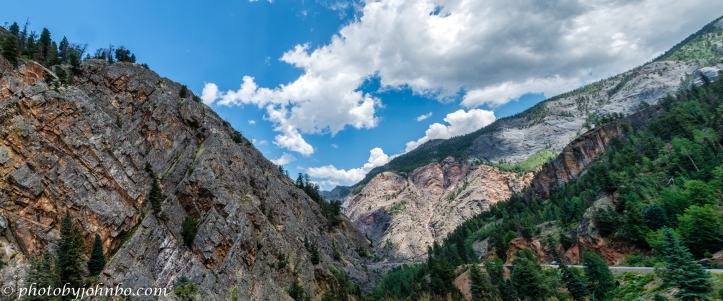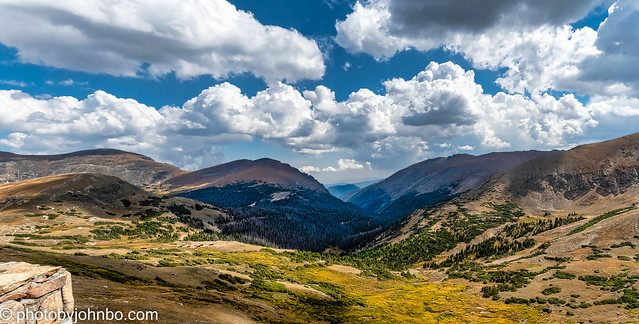
This week, Anne asks us to consider our photographic “groove”. She writes, “…what’s your photo groove? What gives you that sense of accomplishment? Of joy? Of completion? Your challenge this week is to show and tell us about what type of photography you enjoy the most.” You can view her entire challenge post here.
I have spent a decade crossing the country and other parts of the North and Central American continents sharing images along the way. Occasionally, they are cityscapes or street photography, but most are images of the great outdoors. Since learning about HDR, I have bracketed most of my images. For a time, my “groove” was what I now call “grungy HDR”. These days, however, I am much more subtle with HDR, using it only to enhance the dynamic range of an image.
One of the features of Adobe Lightroom is Panorama mode. Take two or more images that share a portion of the landscape and ask Lightroom to stitch them together into a single, usually extra-wide image. The image above, for example, is a six-image HDR panorama. This view of Colorado’s Million Dollar Highway, a section of U.S. 550 between Ouray and Silverton, Colorado.
All of the images in this post are first merged from a three-exposure bracket set, then the resulting HDR images are stitched with Adobe Lightroom. In fact, the latest release of Lightroom allows the photographer to select a group of bracketed exposures and stitch them together in a single operation.
To provide a visual of a six-image HDR merge, here’s an example. I select the two 3-image bracket sets in Lightroom. Then I choose the HDR Panorama Merge option in Lightroom. You may notice that Lightroom doesn’t care whether the left or right bracket set is first, it creates two HDR images, then stitches them in the appropriate place, in this case reversing the two images as needed. This process also eliminates the need to create intermediate HDR images to merge into the final panorama.
Once Lightroom has created the panorama in a single step, I process the file, crop and tweak in Luminar Neo, and it’s done.
The panoramic image above, captured by my drone, was converted to simulated HDR and stitched from two images captured by my DJI Mavic Air drone. A raw image can be processed into brackets by creating three different images, each saved as a DNG with a different exposure setting in Lightroom, one-stop above the correct exposure, one-stop below the correct exposure, and one with the correct exposure for the image. The three exposures are then processed into HDR by Lightroom. Do this process twice to create the simulated HDR of two adjoining images, then stitch the two different HDR views into a single panoramic image. It’s a lot of work, but it can achieve some pretty decent results.
You can climb a 14,000-foot (4267 m) mountain in your car on the highest scenic highway in the United States. There are plenty of pull-offs where you can stop to capture images of mountain goats, or in this case, a moody landscape on a cloudy day.
Rocky Mountain National Park features drives from the lowland meadows to high above the tree line. There are lots of places to stop and admire the views. This view was created by two three-bracket image sets.
I saved my favorite image for last, this view from a pull-off on the highway south of the Flaming Gorge Reservoir. It, too, was created by two 3-bracket images merged into HDR and then stitched into a panoramic view.
Thanks to Anne for her challenge that allowed me to share some of my latest panoramic HDR landscape images. To get a better view in a gallery and wide-screen format, you can visit the album of images on my Flickr site here. From the album, you can scroll through and pixel peep in 2K HD.
Next week, it’s Patti’s turn to challenge us. If you would like to share your own challenge response to each week’s challengers, but are unsure of how to link your post, you will find the details here.
John Steiner







Excellent editing!
Thanks, Dawn!
These are stunning
Thank you!
Love the rocky mountain view.
Yes panorama photography is interesting subject well suited for land scapes.
HDR adds to the beauty.
Thank you John.
I used to do in my earlier days.
I must try a few panoramas.
I lost touch.
The bad news about panoramas is that if you want them printed, they are almost always a non-standard size. 🙂
I agree.
And it may appear stretched out.
Gorgeous panoramic photos! I especially love the colors and depth of the Rocky Mountains shot. I also have some photos of the Gardens of the Gods, but have not tried Lightroom. I thinking I need to! Thanks for sharing. 😎🤓
Thanks, Dawn. That Rocky Mountain image is one of my favorites.
Many thanks, JS. I have a connection to two of those photos. My wonderful wife and I celebrated one of our wedding anniversaries at Coeur d’Alene. An episode of Everyday Driver, a show/content provider I enjoy very much, featured the million-dollar highway, and not any particular cars, as the star.
Cool. That was our first trip to Coeur d’Alene. It is a magnificent area for landscapes.
Your panoramas are always stunning John, and it’s so interesting to learn more about how you achieve them. I don’t have Lightroom, only Elements, but it does have a more basic panorama function which I could experiment with more I reckon. Thanks for the inspiration!
Give Elements a try sometime and let me know how it works for panaramas, Sarah!
Will do. I’ve done a few in the past but long ago!
Wow John! Beautiful images and a tutorial in one post. I’m going to have to try a panorama. I guess I’m going to catch the wave of your groove!
Give it a go. They make some unique opportunities for a new perspective. Be sure and share your experience!
😊
These are really beautiful John – I’m not sure I’d have shared my secrets LOL! In the early days of HDR one could almost instantly identify the process having been used for the final image. I wouldn’t never have guessed that any of these were HDR – terrific work!
Oops, did I type that out loud? >grin<
I am afraid that I am one of those guilty ones who created those "grunge" HDR images. I still have the raw files, every now and then I consider going in and redoing some into the style I have now adopted. Trouble is, I have too many new images to work on.
Amazing HDR images, John! Love the last one especially. I haven’t proceeded any images from my Lumix. 🙂
Thanks, Amy. I’d love to read and see the results from processing some time.
Fantastic panoramas John. I have never done one. Thank you for sharing these photos and giving me some idea of how they were created.
Give them a try.
You are truly an artist, John!
Thank you for the compliment.
Fabulous panoramas, John! Your explanation was great, too. I’ve gotten lazy and use the Nik collection to create HDR images, but I’d love to do more with panoramas. I hope you’ve framed some of these! They’re gorgeous.
Thanks, Patti. I didn’t know Nik could do HDR merges. I’ll have to check on how that works. I also just got the Luminar HDR module for Neo that I’m experimenting with.
Nik doesn’t merge them. It works with one image and applies filters to it. Not as good, I think as actually merging, but it’s the lazy person’s alternative!!
Thanks for clarifying.
Great subject matter. 😉 Great photos, too. I love the lighting and skies.
Thanks, John!